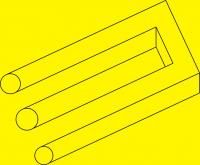plasma torch switch relay for 5i25 / G540
- tommylight
-

- Away
- Moderator
-

Less
More
- Posts: 21029
- Thank you received: 7163
15 Sep 2016 17:19 #80475
by tommylight
Replied by tommylight on topic plasma torch switch relay for 5i25 / G540
You have to ground that module, so add another wire from the DB25 ground to the relay module ground. It will work no matter how you set it as active low or high, just might be reversed.
Please Log in or Create an account to join the conversation.
- dbotos
-
 Topic Author
Topic Author
- Offline
- Senior Member
-

Less
More
- Posts: 65
- Thank you received: 4
16 Sep 2016 02:55 - 16 Sep 2016 03:01 #80481
by dbotos
Replied by dbotos on topic plasma torch switch relay for 5i25 / G540
The combo of tying the grounds together and inverting that ouput did the trick! 
spindle off (default LinuxCNC startup condition or after M05):
IN1 = 2.68 V
relay NO = open
relay NC = closed
LED on relay module = very dim
Could hear relay click off with M05 command.
spindle on (M03, no speed specified):
IN1 = 44.6 mV
relay NO = closed
relay NC = open
LED = on, bright
Could hear relay relay click on.
When I closed LinuxCNC, IN1 went to 1.41 volts and the relay clicked on just like with an M03 command. So I'll have to remember to wait to turn the plasma on until after starting LinuxCNC and turn it off before closing LinuxCNC so I don‘t end up piercing extra holes in things.
spindle off (default LinuxCNC startup condition or after M05):
IN1 = 2.68 V
relay NO = open
relay NC = closed
LED on relay module = very dim
Could hear relay click off with M05 command.
spindle on (M03, no speed specified):
IN1 = 44.6 mV
relay NO = closed
relay NC = open
LED = on, bright
Could hear relay relay click on.
When I closed LinuxCNC, IN1 went to 1.41 volts and the relay clicked on just like with an M03 command. So I'll have to remember to wait to turn the plasma on until after starting LinuxCNC and turn it off before closing LinuxCNC so I don‘t end up piercing extra holes in things.
Last edit: 16 Sep 2016 03:01 by dbotos.
Please Log in or Create an account to join the conversation.
- dbotos
-
 Topic Author
Topic Author
- Offline
- Senior Member
-

Less
More
- Posts: 65
- Thank you received: 4
16 Sep 2016 03:00 - 16 Sep 2016 03:02 #80482
by dbotos
Replied by dbotos on topic plasma torch switch relay for 5i25 / G540
I wonder if I should set the jumpers on the relay module to active high mode and uninvert that output pin on the DB25. Thinking that might solve the issue of the relay turning on when Linux CNC is closed. Will have to try that tomorrow...
Last edit: 16 Sep 2016 03:02 by dbotos.
Please Log in or Create an account to join the conversation.
- dbotos
-
 Topic Author
Topic Author
- Offline
- Senior Member
-

Less
More
- Posts: 65
- Thank you received: 4
16 Sep 2016 13:25 #80499
by dbotos
Replied by dbotos on topic plasma torch switch relay for 5i25 / G540
No love with the active high configuration. The output pin would go high when the spindle was commanded on, but the 2.68 V is just not enough to drive the opto-isolator and switch the relay. So back to active low configuration. I think I'm going to put a SPST switch on one of the torch switch lines coming from the plasma. That way, I can "arm" it right before running a job and then "disarm" it right after the job finishes. Perhaps a better long-term solution would be to get a 3 / 3.3 V relay module and see if the active high configuration works with that. It looks like they make similar relay modules with that voltage and little power supply boards where you plug in a mini/micro USB charger and get 3.3 V as one of the outputs.
Also, a note on the M03 command not needing a speed specified: this does work, but only after specifying a speed with the first M03 command issued. I just did "M03 S100" and after that it would work with plain "M03" commands.
Also, a note on the M03 command not needing a speed specified: this does work, but only after specifying a speed with the first M03 command issued. I just did "M03 S100" and after that it would work with plain "M03" commands.
Please Log in or Create an account to join the conversation.
- tommylight
-

- Away
- Moderator
-

Less
More
- Posts: 21029
- Thank you received: 7163
16 Sep 2016 13:49 #80500
by tommylight
Replied by tommylight on topic plasma torch switch relay for 5i25 / G540
You should change it to active high.
As a rule, plasma is the last thing to turn on and the first thing to turn off.
Without a charge pump, there is a high possibility of ruining a perfectly good piece of metal if that procedure is not followed.
As a rule, plasma is the last thing to turn on and the first thing to turn off.
Without a charge pump, there is a high possibility of ruining a perfectly good piece of metal if that procedure is not followed.
Please Log in or Create an account to join the conversation.
- tommylight
-

- Away
- Moderator
-

Less
More
- Posts: 21029
- Thank you received: 7163
16 Sep 2016 13:55 #80501
by tommylight
Replied by tommylight on topic plasma torch switch relay for 5i25 / G540
ooops
Since it does not work with active high, find a 1Kohm resistor and solder it parallel to the existing one in the relay board, that is the one going from the input to the opto coupler. Optos need only 2V to function properly (some even less) but they need about 10mA to switch the sensor on the other side. This is a much easier ( depending on how you look at it) solution and no fiddling with other stuff when using the machine.
Since it does not work with active high, find a 1Kohm resistor and solder it parallel to the existing one in the relay board, that is the one going from the input to the opto coupler. Optos need only 2V to function properly (some even less) but they need about 10mA to switch the sensor on the other side. This is a much easier ( depending on how you look at it) solution and no fiddling with other stuff when using the machine.
Please Log in or Create an account to join the conversation.
- Rick G
-

- Offline
- Junior Member
-

Less
More
- Posts: 27
- Thank you received: 114
16 Sep 2016 14:01 #80502
by Rick G
Rick G
Replied by Rick G on topic plasma torch switch relay for 5i25 / G540
Absolutely. Best and safest practice.As a rule, plasma is the last thing to turn on and the first thing to turn off.
Rick G
The following user(s) said Thank You: tommylight
Please Log in or Create an account to join the conversation.
- dbotos
-
 Topic Author
Topic Author
- Offline
- Senior Member
-

Less
More
- Posts: 65
- Thank you received: 4
16 Sep 2016 16:47 - 16 Sep 2016 16:48 #80503
by dbotos
Replied by dbotos on topic plasma torch switch relay for 5i25 / G540
I'll have to see what opto is on the board and dig up a datasheet or just take some measurements with 5V driving. You'd want the same amount of current flowing through the left side of the opto with 3V as you would with 5V so you don't over-current the opto or the LED downstream. Like Tommy said, that R1 could be lowered to get more current with the lower driving voltage. But not too much (current)...
Not too much
Not too much
Last edit: 16 Sep 2016 16:48 by dbotos.
Please Log in or Create an account to join the conversation.
- tommylight
-

- Away
- Moderator
-

Less
More
- Posts: 21029
- Thank you received: 7163
16 Sep 2016 17:26 #80504
by tommylight
Replied by tommylight on topic plasma torch switch relay for 5i25 / G540
That is the best way, check and then add as needed.
Done that on way to many chinese BOB's. They use cheap optos that are to damn slow.
Done that on way to many chinese BOB's. They use cheap optos that are to damn slow.
Please Log in or Create an account to join the conversation.
- dbotos
-
 Topic Author
Topic Author
- Offline
- Senior Member
-

Less
More
- Posts: 65
- Thank you received: 4
18 Sep 2016 00:37 #80548
by dbotos
Replied by dbotos on topic plasma torch switch relay for 5i25 / G540
Took some measurements today:
VCC = 5.08 V
V_R1 = 2.14 V
V_F = 1.10 V (anode to cathode of the input side of the opto)
V_LED = 1.84 V (the SMD indicator LED)
i_F = 2.14 mA
V_R1 + V_F + V_LED adds up to VCC, which is good. If I get rid of R1 (jumper over it), then V_F + V_LED = 2.94 V, which is not too far off from the 2.68 V that I was getting from the active high output on the DB25 pin. Hopefully it'll still provide enough forward current to make the opto function correctly. If proportional (2.68 / 2.94 * i_F_original), new forward current should be about 1.95 mA.
VCC = 5.08 V
V_R1 = 2.14 V
V_F = 1.10 V (anode to cathode of the input side of the opto)
V_LED = 1.84 V (the SMD indicator LED)
i_F = 2.14 mA
V_R1 + V_F + V_LED adds up to VCC, which is good. If I get rid of R1 (jumper over it), then V_F + V_LED = 2.94 V, which is not too far off from the 2.68 V that I was getting from the active high output on the DB25 pin. Hopefully it'll still provide enough forward current to make the opto function correctly. If proportional (2.68 / 2.94 * i_F_original), new forward current should be about 1.95 mA.
Please Log in or Create an account to join the conversation.
Moderators: PCW, jmelson
Time to create page: 0.096 seconds
